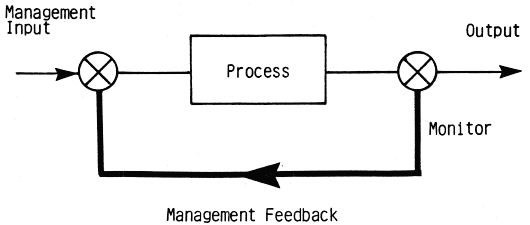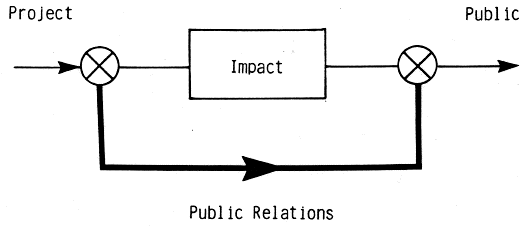The Public Relations Concept
Information feedback to management is an essential part of the
management process.

Traditional management feedback system
It can be an essential and powerful tool in improving motivation
at the operative level. If it is properly handled, improved productivity
will follow. In effect the traditional feed back is made to work
in the reverse direction, and whether appropriate information is
presented in verbal, written or graphical form, improvement in performance
can be quite remarkable. This is just as true in the field of projects
whether they are large or small, and applies equally to those working
on the project as well as those affected by it.

Public Relations feed forward system
On a major project, particularly if it is publicly
funded, a general information and progress center is quite normal.
Equipped with visual aids for presentations, it will exhibit not
only pictures, diagrams and models, but up-to-date charts of schedule
and progress information suitable for the public at large as well
as the project work force. Known in the trade as Public Relations,
this whole effort is a vital part of managing the project. It can
prove invaluable to project management in helping to control all
aspects of a complex project.
In general terms Public Relations, or PR as it is more frequently
termed, may simply be defined as "An activity designed to improve
the environment in which an organization operates in order to improve
the performance of that organization." From this definition
it will be noted that the public interest groups, or target areas
of the program, are clearly both internal and external to the project.
Unfortunately, to many people the term Public Relations is somewhat
vague and self serving and its use may therefore be undesirable.
However, there appears to be no really satisfactory term for an
activity which should be a legitimate project function. The image
of the "PR man" tends to be one of a smooth, fast talking
individual replete with over worked clich³s. Little distinction
is drawn between PR and marketing, promotion or just hard selling
where the message is deliberately one sided.
"Public Participation" is another description for a similar
-activity which attempts to deal with the environmental and social
impacts of a project. In many jurisdictions it is prescribed by
government regulations. Its perception tends to be one of interference
with project objectives, escalating cost and schedule delays.
A more dynamic and acceptable term might be "Communication
Plan", provided that this term does not conflict with responsibilities
elsewhere in the project organization. It is perhaps the most innocuous
of the available terms, for without ample definition it fails almost
completely to convey its purpose.
Whatever title is preferred, every project team should bear in
mind that most capital projects are the target of negative information
campaigns. These are usually mounted by those with other vested
interests. Such special interest groups may seek to have the project
delayed or cancelled to preserve the status quo, or otherwise held
to ransom for their own pecuniary gain. Like bees to the honey pot,
the News Media is much more likely to be attracted to such biased
and often uninformed positions as being more "newsworthy"
than the official project press releases.
The cry of the critics will likely include: The technology is untried;
safety is at stake; the environment will be adversely impacted;
indirect costs will be incurred by the community; taxpayers will
be saddled with increased taxes and so on. Of course, within the
local community there may be some individual hardship cases which
will attract political and media attention, especially if the project
has to acquire property for its implementation. In this case, people's
homes, businesses and lifestyles may indeed be affected. In addition,
actual construction, pile driving, trucking and road restrictions
or congestion will create issues which will demand immediate and
effective response.
All of these issues should be foreseen, recognized and dealt with
honestly, fairly and promptly. Understand that everyone who works
on the project contributes to its image. Make sure that that contribution
is positive.
To a large extent, the project team's ability, to control the project
environment will determine their ability to control the project
in terms of cost and schedule.
|



